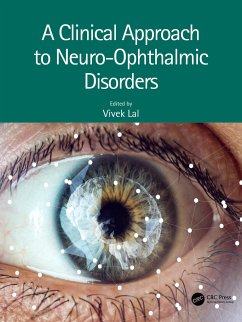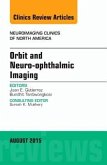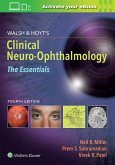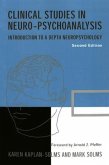A Clinical Approach to Neuro-Ophthalmic Disorders
Herausgeber: Lal, Vivek
A Clinical Approach to Neuro-Ophthalmic Disorders
Herausgeber: Lal, Vivek
- Broschiertes Buch
- Merkliste
- Auf die Merkliste
- Bewerten Bewerten
- Teilen
- Produkt teilen
- Produkterinnerung
- Produkterinnerung
Neuro-ophthalmology is a merged subspecialty of neurology and ophthalmology dealing with complex multisystem diseases presenting with visual manifestations. This book helps the reader in recognizing, approaching, and managing such a patient.
Andere Kunden interessierten sich auch für
![Orbit and Neuro-Ophthalmic Imaging, an Issue of Neuroimaging Clinics Orbit and Neuro-Ophthalmic Imaging, an Issue of Neuroimaging Clinics]() Juan E. GutierrezOrbit and Neuro-Ophthalmic Imaging, an Issue of Neuroimaging Clinics113,99 €
Juan E. GutierrezOrbit and Neuro-Ophthalmic Imaging, an Issue of Neuroimaging Clinics113,99 €![Walsh & Hoyt's Clinical Neuro-Ophthalmology: The Essentials Walsh & Hoyt's Clinical Neuro-Ophthalmology: The Essentials]() Miller, Neil, MDWalsh & Hoyt's Clinical Neuro-Ophthalmology: The Essentials174,99 €
Miller, Neil, MDWalsh & Hoyt's Clinical Neuro-Ophthalmology: The Essentials174,99 €![Theory of Mind in Middle Childhood and Adolescence Theory of Mind in Middle Childhood and Adolescence]() Theory of Mind in Middle Childhood and Adolescence54,99 €
Theory of Mind in Middle Childhood and Adolescence54,99 €![Clinical Studies in Neuro-psychoanalysis Clinical Studies in Neuro-psychoanalysis]() Karen Kaplan-SolmsClinical Studies in Neuro-psychoanalysis82,99 €
Karen Kaplan-SolmsClinical Studies in Neuro-psychoanalysis82,99 €![Creativity in the Classroom Creativity in the Classroom]() Alane Jordan Starko (USA Eastern Michigan University)Creativity in the Classroom182,99 €
Alane Jordan Starko (USA Eastern Michigan University)Creativity in the Classroom182,99 €![Creativity in the Classroom Creativity in the Classroom]() Alane Jordan Starko (USA Eastern Michigan University)Creativity in the Classroom79,99 €
Alane Jordan Starko (USA Eastern Michigan University)Creativity in the Classroom79,99 €![Ophthalmic Epidemiology Ophthalmic Epidemiology]() Ophthalmic Epidemiology111,99 €
Ophthalmic Epidemiology111,99 €-
-
-
Neuro-ophthalmology is a merged subspecialty of neurology and ophthalmology dealing with complex multisystem diseases presenting with visual manifestations. This book helps the reader in recognizing, approaching, and managing such a patient.
Hinweis: Dieser Artikel kann nur an eine deutsche Lieferadresse ausgeliefert werden.
Hinweis: Dieser Artikel kann nur an eine deutsche Lieferadresse ausgeliefert werden.
Produktdetails
- Produktdetails
- Verlag: Taylor & Francis Ltd
- Seitenzahl: 348
- Erscheinungstermin: 28. Oktober 2022
- Englisch
- Abmessung: 209mm x 277mm x 23mm
- Gewicht: 1108g
- ISBN-13: 9781032251486
- ISBN-10: 1032251484
- Artikelnr.: 62953464
- Verlag: Taylor & Francis Ltd
- Seitenzahl: 348
- Erscheinungstermin: 28. Oktober 2022
- Englisch
- Abmessung: 209mm x 277mm x 23mm
- Gewicht: 1108g
- ISBN-13: 9781032251486
- ISBN-10: 1032251484
- Artikelnr.: 62953464
Dr Vivek Lal MD (Medicine), DM (Neurology), FIAN, FRCP (Edin) studied medicine and did his training in Neurology at the prestigious Postgraduate Institute of Medical Education and Research (PGIMER) Chandigarh, India. He is currently Professor and Head of the department of Neurology at PGIMER, Chandigarh, India. He also served as Dean of Baba Farid University of Health Sciences (BFUHS), Punjab, India. He is a member of editorial team of Neuro-Ophthalmology, Annals of Indian Academy of Neurology and Indian edition of European journal of Neurology. He is a fellow of Royal College of Physicians (FRCP), Edinburgh and Fellow Indian academy of Neurology (FIAN). He is also the chairman of Neuro-Ophthalmology subsection of the Indian Academy of Neurology. His major areas of interest are Neuro-Ophthalmology, Neuroimmunology and Headache. He has been instrumental in introducing the concept of systematic Neuro-Ophthalmology in India. He runs a Neuro-Ophthalmology sub-specialty clinic catering to the patients from all over India.
Table of Contents
PART A- BASICS OF NEUROOPHTHALMOLOGY
1. Clinical Examination in Neuro-Ophthalmology
2. Visual Fields in Neuro-ophthalmology
3a. OCT and FFA in Neuro-ophthalmology
3b. Visual Evoked Potential in neuro-ophthalmology
PART B- NEUROOPHTHALMOLOGY: THE AFFERENT PATHWAY
4. Approach to Visual Loss
5. Optic Neuropathies associated with Multiple Sclerosis (MS) and
Neuromyelitis Optica Spectrum Disorders (NMOSD)
6. Papilledema: Diagnosis and Management
7. Optic Neuropathies Associated with Radiation and Systemic Inflammatory
Disorders
8. Infectious optic neuropathies
9.Ischemic Optic Neuropathies
10. Infiltrative Optic Neuropathies
11. Nutritional Optic Neuropathy
12. Hereditary Optic Neuropathy
13. Non-Organic Vision Loss
PART C: NEUROOPHTHALMOLOGY: THE EFFERENT PATHWAY
14. An Approach To Pupillary Disorders - Physiology And Pathology
15. Ophthalmoplegia- Diagnosis and Management
15a. Ocular Motor Cranial Neuropathies
15b. Neuromuscular Junction Syndromes and Ocular Myopathies
15c. Orbital Inflammatory Syndromes
15d. Congenital Cranial Dysinnervation Disorder
16. Infection-associated Ocular Cranial Nerve Palsies
PART D: HIGHER VISUAL PATHWAYS
17. An Approach to patient with Gaze Disorder
18. A Clinical Approach to Abnormal Eye Movements
19. Special Considerations in Gaze
19a. Physiology and Disorders of Saccade Velocity
19b. Disorders of Gaze Holding
20. Cortical Visual Loss
PART E: SPECIAL CONSIDERATIONS IN NEUROOPHTHALMOLOGY
21a. An Approach To Visual Loss In A Child
21b. An Approach to Oculomotor Anomalies in a Child
22. Radiological interpretation in Neuroophthalmology
23. Neuro-ophthalmological findings in Patients with Posterior Circulation
Stroke
24. Toxins in Neuro-Ophthalmology
25. Neuropathology of Neuro-Ophthalmic Disorders
PART A- BASICS OF NEUROOPHTHALMOLOGY
1. Clinical Examination in Neuro-Ophthalmology
2. Visual Fields in Neuro-ophthalmology
3a. OCT and FFA in Neuro-ophthalmology
3b. Visual Evoked Potential in neuro-ophthalmology
PART B- NEUROOPHTHALMOLOGY: THE AFFERENT PATHWAY
4. Approach to Visual Loss
5. Optic Neuropathies associated with Multiple Sclerosis (MS) and
Neuromyelitis Optica Spectrum Disorders (NMOSD)
6. Papilledema: Diagnosis and Management
7. Optic Neuropathies Associated with Radiation and Systemic Inflammatory
Disorders
8. Infectious optic neuropathies
9.Ischemic Optic Neuropathies
10. Infiltrative Optic Neuropathies
11. Nutritional Optic Neuropathy
12. Hereditary Optic Neuropathy
13. Non-Organic Vision Loss
PART C: NEUROOPHTHALMOLOGY: THE EFFERENT PATHWAY
14. An Approach To Pupillary Disorders - Physiology And Pathology
15. Ophthalmoplegia- Diagnosis and Management
15a. Ocular Motor Cranial Neuropathies
15b. Neuromuscular Junction Syndromes and Ocular Myopathies
15c. Orbital Inflammatory Syndromes
15d. Congenital Cranial Dysinnervation Disorder
16. Infection-associated Ocular Cranial Nerve Palsies
PART D: HIGHER VISUAL PATHWAYS
17. An Approach to patient with Gaze Disorder
18. A Clinical Approach to Abnormal Eye Movements
19. Special Considerations in Gaze
19a. Physiology and Disorders of Saccade Velocity
19b. Disorders of Gaze Holding
20. Cortical Visual Loss
PART E: SPECIAL CONSIDERATIONS IN NEUROOPHTHALMOLOGY
21a. An Approach To Visual Loss In A Child
21b. An Approach to Oculomotor Anomalies in a Child
22. Radiological interpretation in Neuroophthalmology
23. Neuro-ophthalmological findings in Patients with Posterior Circulation
Stroke
24. Toxins in Neuro-Ophthalmology
25. Neuropathology of Neuro-Ophthalmic Disorders
Table of Contents
PART A- BASICS OF NEUROOPHTHALMOLOGY
1. Clinical Examination in Neuro-Ophthalmology
2. Visual Fields in Neuro-ophthalmology
3a. OCT and FFA in Neuro-ophthalmology
3b. Visual Evoked Potential in neuro-ophthalmology
PART B- NEUROOPHTHALMOLOGY: THE AFFERENT PATHWAY
4. Approach to Visual Loss
5. Optic Neuropathies associated with Multiple Sclerosis (MS) and
Neuromyelitis Optica Spectrum Disorders (NMOSD)
6. Papilledema: Diagnosis and Management
7. Optic Neuropathies Associated with Radiation and Systemic Inflammatory
Disorders
8. Infectious optic neuropathies
9.Ischemic Optic Neuropathies
10. Infiltrative Optic Neuropathies
11. Nutritional Optic Neuropathy
12. Hereditary Optic Neuropathy
13. Non-Organic Vision Loss
PART C: NEUROOPHTHALMOLOGY: THE EFFERENT PATHWAY
14. An Approach To Pupillary Disorders - Physiology And Pathology
15. Ophthalmoplegia- Diagnosis and Management
15a. Ocular Motor Cranial Neuropathies
15b. Neuromuscular Junction Syndromes and Ocular Myopathies
15c. Orbital Inflammatory Syndromes
15d. Congenital Cranial Dysinnervation Disorder
16. Infection-associated Ocular Cranial Nerve Palsies
PART D: HIGHER VISUAL PATHWAYS
17. An Approach to patient with Gaze Disorder
18. A Clinical Approach to Abnormal Eye Movements
19. Special Considerations in Gaze
19a. Physiology and Disorders of Saccade Velocity
19b. Disorders of Gaze Holding
20. Cortical Visual Loss
PART E: SPECIAL CONSIDERATIONS IN NEUROOPHTHALMOLOGY
21a. An Approach To Visual Loss In A Child
21b. An Approach to Oculomotor Anomalies in a Child
22. Radiological interpretation in Neuroophthalmology
23. Neuro-ophthalmological findings in Patients with Posterior Circulation
Stroke
24. Toxins in Neuro-Ophthalmology
25. Neuropathology of Neuro-Ophthalmic Disorders
PART A- BASICS OF NEUROOPHTHALMOLOGY
1. Clinical Examination in Neuro-Ophthalmology
2. Visual Fields in Neuro-ophthalmology
3a. OCT and FFA in Neuro-ophthalmology
3b. Visual Evoked Potential in neuro-ophthalmology
PART B- NEUROOPHTHALMOLOGY: THE AFFERENT PATHWAY
4. Approach to Visual Loss
5. Optic Neuropathies associated with Multiple Sclerosis (MS) and
Neuromyelitis Optica Spectrum Disorders (NMOSD)
6. Papilledema: Diagnosis and Management
7. Optic Neuropathies Associated with Radiation and Systemic Inflammatory
Disorders
8. Infectious optic neuropathies
9.Ischemic Optic Neuropathies
10. Infiltrative Optic Neuropathies
11. Nutritional Optic Neuropathy
12. Hereditary Optic Neuropathy
13. Non-Organic Vision Loss
PART C: NEUROOPHTHALMOLOGY: THE EFFERENT PATHWAY
14. An Approach To Pupillary Disorders - Physiology And Pathology
15. Ophthalmoplegia- Diagnosis and Management
15a. Ocular Motor Cranial Neuropathies
15b. Neuromuscular Junction Syndromes and Ocular Myopathies
15c. Orbital Inflammatory Syndromes
15d. Congenital Cranial Dysinnervation Disorder
16. Infection-associated Ocular Cranial Nerve Palsies
PART D: HIGHER VISUAL PATHWAYS
17. An Approach to patient with Gaze Disorder
18. A Clinical Approach to Abnormal Eye Movements
19. Special Considerations in Gaze
19a. Physiology and Disorders of Saccade Velocity
19b. Disorders of Gaze Holding
20. Cortical Visual Loss
PART E: SPECIAL CONSIDERATIONS IN NEUROOPHTHALMOLOGY
21a. An Approach To Visual Loss In A Child
21b. An Approach to Oculomotor Anomalies in a Child
22. Radiological interpretation in Neuroophthalmology
23. Neuro-ophthalmological findings in Patients with Posterior Circulation
Stroke
24. Toxins in Neuro-Ophthalmology
25. Neuropathology of Neuro-Ophthalmic Disorders







